The transient’s key findings are:
- Lengthy-term care (LTC) prices are usually not effectively insured, posing a big danger for older households as they age.
- Utilizing new survey knowledge, the evaluation compares what respondents say they might do if LTC prices exceeded their sources to what individuals like them truly do.
- The important thing outcomes are:
- many plan to depend on Medicaid, however, in actuality, solely a small fraction will meet its strict eligibility standards;
- in distinction, individuals don’t anticipate to faucet residence fairness, however sometimes find yourself doing so; and
- amongst those that do want LTC providers, few discover it needed to maneuver in with their youngsters, however they do anticipate to depart them much less cash.
Introduction
Even the best-laid plans can go awry. Retirees face the danger of a giant healthcare spending shock for medical or long-term care (LTC) both as a result of their medical insurance entails important value sharing or as a result of they lack insurance coverage fully within the case of LTC. If these shocks are sufficiently big, they will devastate a family’s funds. The query is how do retirees reply when confronted with expenditures that exceed their sources?
This transient, which relies on a current paper, addresses retirees’ responses in two steps.1 The primary experiences the outcomes of a current survey on how older households understand medical and LTC dangers in retirement and the way they plan to reply if their sources show insufficient. The evaluation then turns to the Well being and Retirement Examine (HRS), a big longitudinal survey, to find out how households truly reply following a serious healthcare expenditure.
The dialogue proceeds as follows. The primary part describes the extent to which people are insured for healthcare shocks. The second part summarizes the survey outcomes on people’ perceptions of doable prices and the way they may reply if sources are inadequate. The third part describes the information and methodology for the HRS evaluation, and the fourth part presents the outcomes. The ultimate part concludes that whereas retirees are comparatively well-insured in opposition to medical shocks – with implications seemingly restricted to reductions in anticipated bequests – they’re very uncovered to surprising LTC expenditures, typically resulting in a drawdown of residence fairness or reliance on Medicaid.
Insurance coverage in opposition to Healthcare Dangers in Retirement
On this transient, we use “healthcare” to seek advice from any health-related prices, whether or not they contain periodic medical care or long-term care. Beginning off with medical prices, Medicare covers practically all adults ages 65+, and about half had a Medicare Benefit plan in 2021 (see Determine 1).2 The rest sometimes have a mixture of Conventional Medicare and supplemental protection both from an employer (present or earlier), a Medigap plan, or Medicaid. Solely 5 % of these over 65 are coated solely by Conventional Medicare. Given the in depth protection, retirees’ publicity to prices happens via the extent of cost-sharing they face underneath the completely different preparations. Whereas such cost-sharing might be substantial in Conventional Medicare, the overwhelming majority of retirees have some type of supplemental association that may cut back the burden.
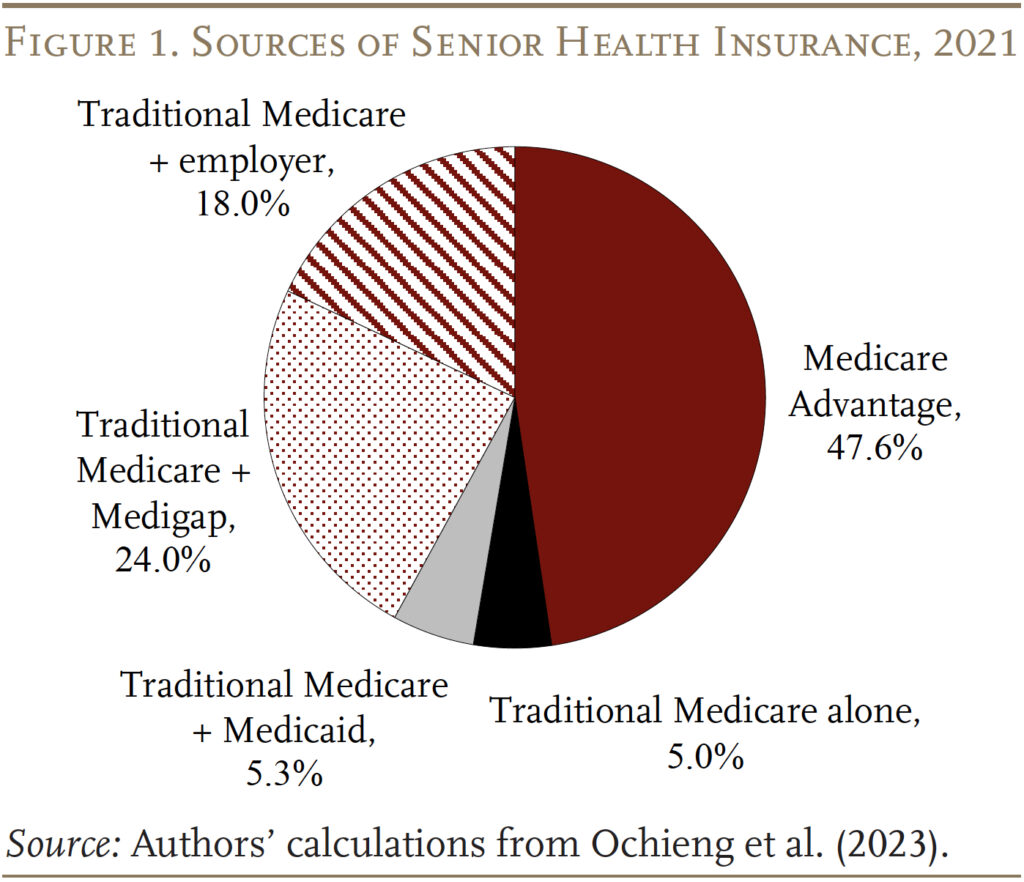
Even with supplemental insurance coverage to enhance Medicare, cost-sharing for physician and hospital providers sometimes entails some copay or coinsurance. Whereas annual prices are capped by supplemental plans and Medicare Benefit (although not in Conventional Medicare), these caps should go away households uncovered to 1000’s of {dollars} of annual prices. In 2024, Medicare Benefit plans had been required to cap annual prices to enrollees at $8,850 for in-network providers and $13,300 for out-of-network providers; and, since many households are married {couples}, the family cap is successfully doubled for them.3
One other supply of uninsured expenditure – for the interval coated within the following HRS evaluation – is prescribed drugs. Medicare drug protection initially included substantial gaps, and supplemental plans in these years additionally typically didn’t cowl medication. Furthermore, when the Half D drug profit was added to Medicare in 2006, retirees nonetheless confronted a “donut gap” of 1000’s of {dollars} a 12 months of drug prices that had been uncovered till they hit “catastrophic” ranges of spending (after which they nonetheless confronted a 5-percent coinsurance charge). Not too long ago, the donut gap and price sharing for catastrophic protection had been eradicated, however these prices are necessary for the pattern interval on this evaluation.
Whereas retirees are pretty effectively protected in opposition to the price of medical shocks, they’re uncovered to substantial LTC dangers. About 80 % of these ages 65+ would require some LTC, with practically 20 % requiring high-intensity look after greater than three years.4 However solely 4 % of the hours required is roofed by insurance coverage (see Determine 2).5
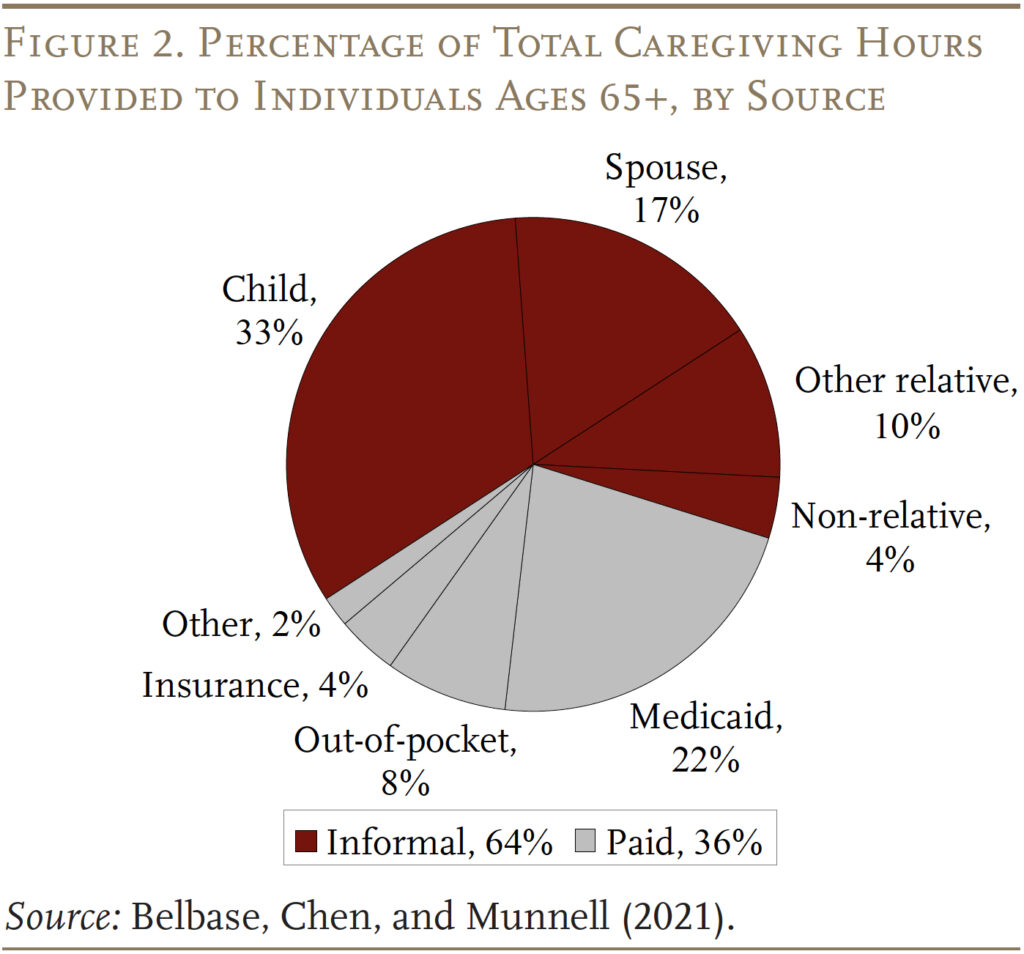
The remainder is roofed primarily by casual care from members of the family, and the lion’s share of paid care is ultimately coated by Medicaid. Nevertheless, Medicaid eligibility requires the family to be impoverished. In 2024, the earnings restrict for Medicaid eligibility for these over age 65 was sometimes round $2,800 per 30 days ($5,600 for {couples}) and the asset restrict was sometimes $2,000 ($3,000 for {couples}), however varies by state. Thus, Medicaid is a security web, however not an efficient type of insurance coverage, since its deductible is just about all a family’s property.6 The shortage of insurance coverage for formal care is troubling, provided that the median annual prices in 2023 had been $116,800 for a non-public room in a nursing residence, $64,200 for an assisted residing facility, and $75,500 for residence well being aides.7
In sum, retirees are uncovered to average medical spending – largely capped at round $20,000 per 12 months for a married family with Medicare Benefit. Whereas no small sum, it’s unlikely to fully derail a family’s long-term funds, though it could require changes (significantly as many medical circumstances persist for years). In distinction, the prices of LTC can simply overwhelm family funds with only a few years of intensive care.
The economics literature on how retirees fare financially within the wake of a healthcare spending shock is surprisingly restricted. In an try to fill that hole, the next experiences the outcomes of a current family survey on individuals’s perceptions of doable shocks and their fallback plans if sources are insufficient. These outcomes are then supplemented with findings from the HRS describing what truly occurs to retirees within the wake of a healthcare shock.
Survey Outcomes
In July 2024, Greenwald Analysis interviewed on-line 508 people ages 48-78 with a minimum of $100,000 in investable property. All of the respondents had been concerned within the monetary decision-making of their households. The survey requested individuals about their perceived probability of experiencing a medical shock or needing in depth LTC, in addition to the potential value of those occasions. A key discovering, in line with different research, was that medical and LTC dangers had been usually low on their listing of considerations (see Determine 3).8 Furthermore, responses to detailed questions within the current survey in regards to the probability of needing care and the price of that care reinforce the notion that older adults underestimate the dangers and prices.
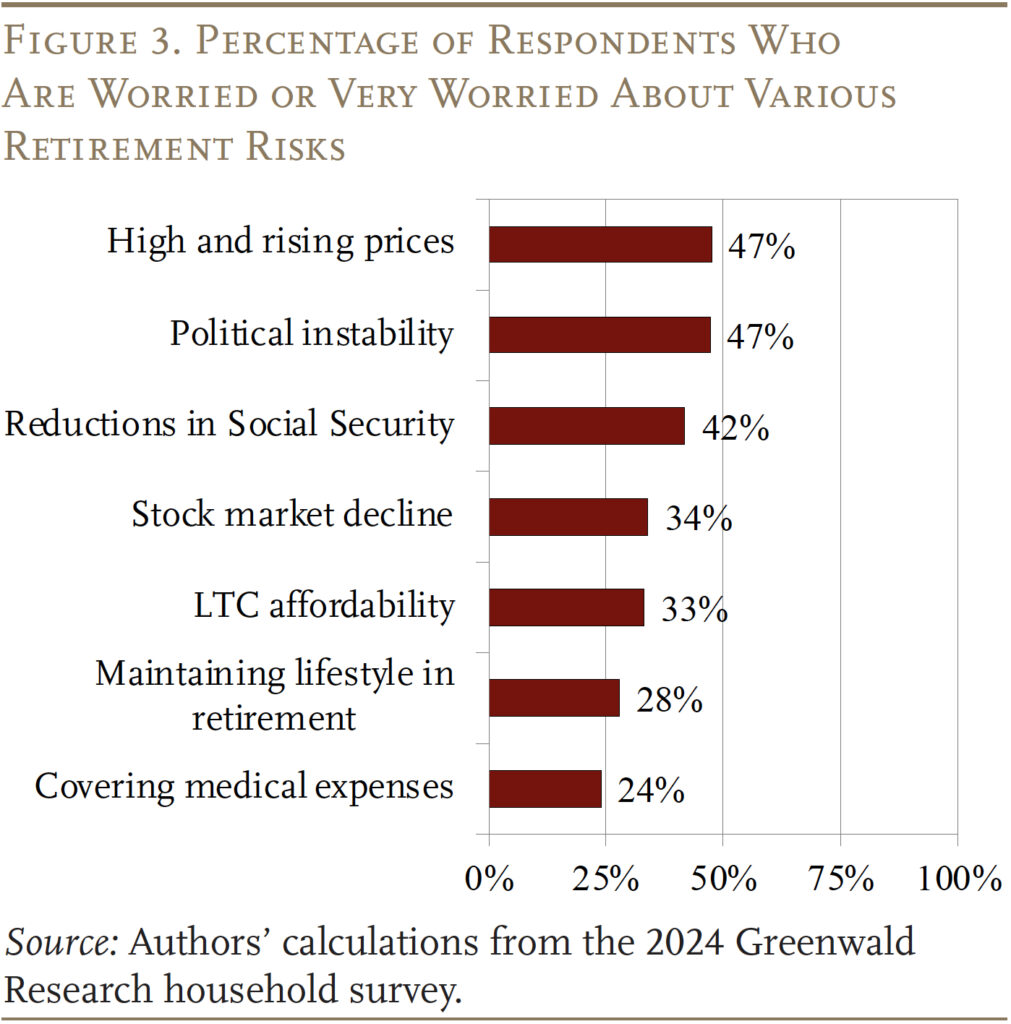
Underestimating the dangers of huge outlays for healthcare implies that households won’t have ample insurance coverage or monetary sources to cowl such wants in the event that they come up. When requested what options they might contemplate if they might not afford their healthcare bills, over 60 % stated they might contemplate spending right down to Medicaid, whereas solely 30 % stated they might think about using their residence fairness or transferring in with their kids (see Determine 4). The query is to what extent are these options cheap? To reply that query, the evaluation turns to the HRS.
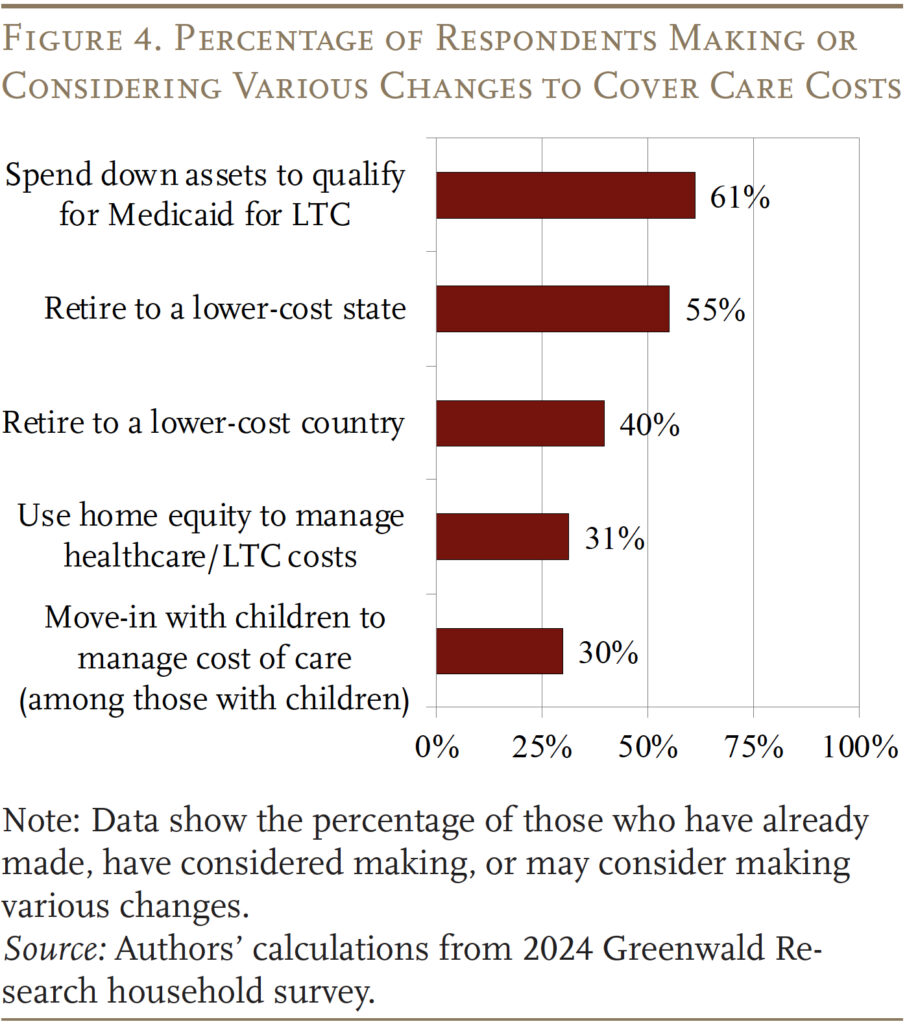
HRS Evaluation – Pattern and Methodology
The HRS is a biennial survey consultant of the U.S. inhabitants over age 50 and their spouses. This evaluation limits the pattern to the Medicare-covered inhabitants ages 65+ and, to be in line with the current on-line survey, focuses on these with $100,000+ in investable property. Though all respondents are initially non-institutionalized when first interviewed, they’re tracked and re-interviewed whilst they enter nursing properties and different establishments. Moreover, the HRS contains questions on healthcare bills by kind: docs, hospitals, prescribed drugs, outpatient surgical procedure, and dental prices on the medical entrance; and nursing residence care and residential care on the LTC entrance.
These healthcare bills are used to outline “medical shock” and “LTC shock.” People are thought-about to have had a medical shock in a given 12 months if spending was within the prime 10 % of medical out-of-pocket bills in that 12 months. For LTC, as a result of out-of-pocket spending is comparatively uncommon, a shock is outlined as having any LTC-related spending. People with a number of years of excessive spending are thought-about to have had the shock within the first 12 months, with the following years seen as associated to the preliminary occasion. This course of yields practically 1,500 distinctive people within the LTC shock group and round 4,000 within the medical shock group. All quantities are inflated to 2023 {dollars}.
The evaluation explores 4 methods through which a big healthcare expense might have an effect on a person’s life. The primary, and doubtless an important, is the choice to enroll in Medicaid. The second is any affect on family property – total, residential, and non-residential – with an eye fixed towards assessing if the shock results in downsizing to fund the expense. The third entails a change in residing preparations, similar to transferring in with kids to extra simply obtain care. Lastly, a big healthcare expense might have an effect on a person’s expectations about leaving a bequest.9
To investigate the consequences of shocks, one should cope with the truth that the households bearing such giant prices will not be much like these with out shocks. They might have had poorer well being their complete lives, lack adequate insurance coverage protection attributable to preexisting circumstances or an absence of sources, or just have completely different danger preferences. Such variations are onerous to regulate for statistically in a regression. To handle this drawback, the evaluation compares those that expertise a shock in a given 12 months to those that will expertise the shock at a while within the close to future.10 The expectation is that a person with a big healthcare expenditure in a particular 12 months needs to be related on all method of unobservable traits to at least one hit by the identical shock only a few years later, if the exact timing of such shocks is near random.
Thus, the evaluation entails matching the group of people struggling a shock with a “management” group of people experiencing the identical kind of shock 4 years later. On this method, the consequences of the shock might be estimated on the time of affect, and as much as two years later.11 As soon as the “shock” teams and management teams are outlined, a regression equation is used to estimate the affect of the shock – LTC or medical – on the 4 outcomes – Medicaid, wealth, residing with kids, and bequest expectations.
HRS Evaluation – Outcomes
The part begins with a take a look at the traits of the survey individuals, adopted by the outcomes for the evaluation of healthcare shocks.
Descriptive Information
Earlier than how individuals reply to giant monetary shocks, some descriptive knowledge regarding the pattern and to the magnitude of the healthcare expenditures present a helpful backdrop. Desk 1 presents the imply demographics for the 2 “shock” teams. These two samples are each broadly related, besides that these struggling an LTC shock have a imply age of 82 in comparison with 76 for these with a medical shock. As well as, the medical-shock group tends to have considerably extra training, larger wealth and, correspondingly, higher expectations of leaving giant bequests.12
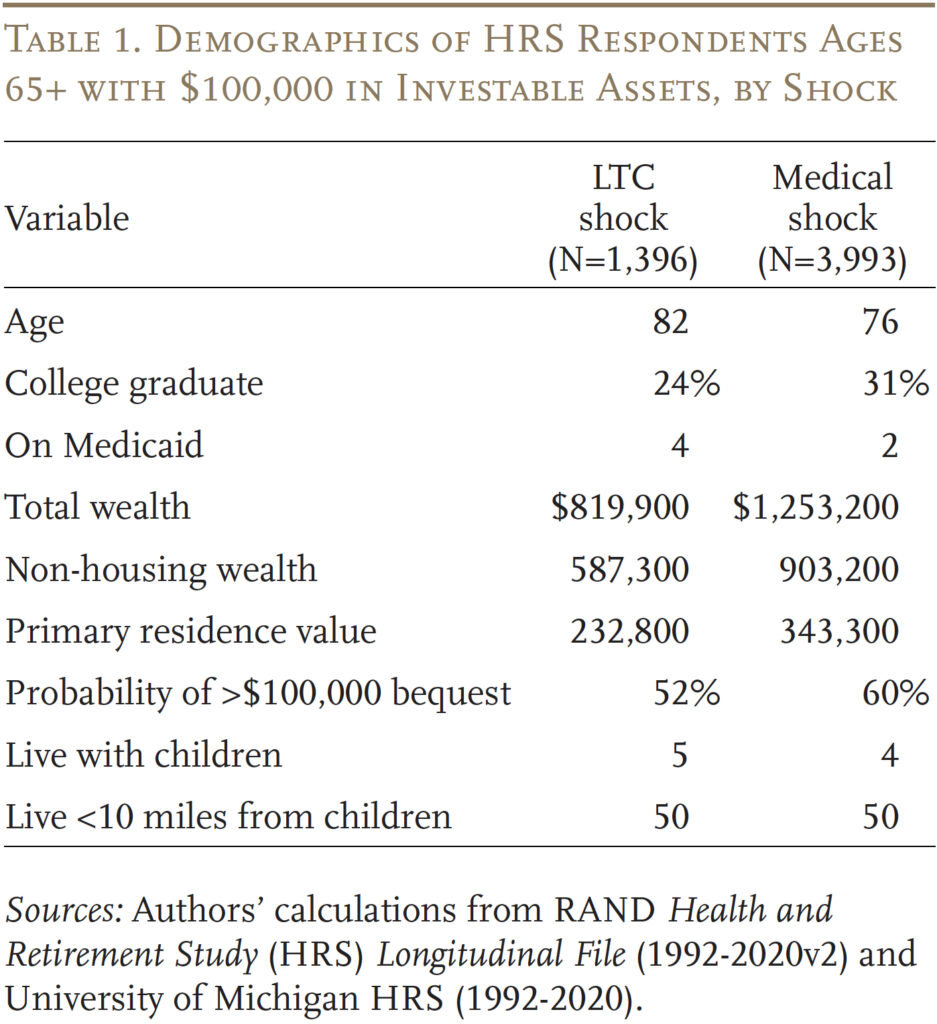
Desk 2 shows imply out-of-pocket (OOP) prices within the 12 months of the shock for these with an LTC shock and people with a medical shock. Total, annual prices are fairly excessive and related for each samples – about $11,000. The usual deviation (SD) of those prices can be giant – a person who’s one customary deviation above the imply would face practically $30,000 of bills within the shock 12 months.13 Roughly two-thirds of LTC bills are nursing properties, whereas inside medical care, about half of bills are for prescribed drugs. This latter discovering is no surprise provided that many of those shock years occurred earlier than Medicare Half D, and all earlier than the elimination of the donut gap in the usual Half D profit. Curiously, whereas the medical group has a lot larger medical than LTC spending, the converse doesn’t maintain for the LTC pattern. That group truly faces larger medical than LTC prices, displaying that people going through giant LTC bills sometimes additionally bear giant medical bills on the similar time.
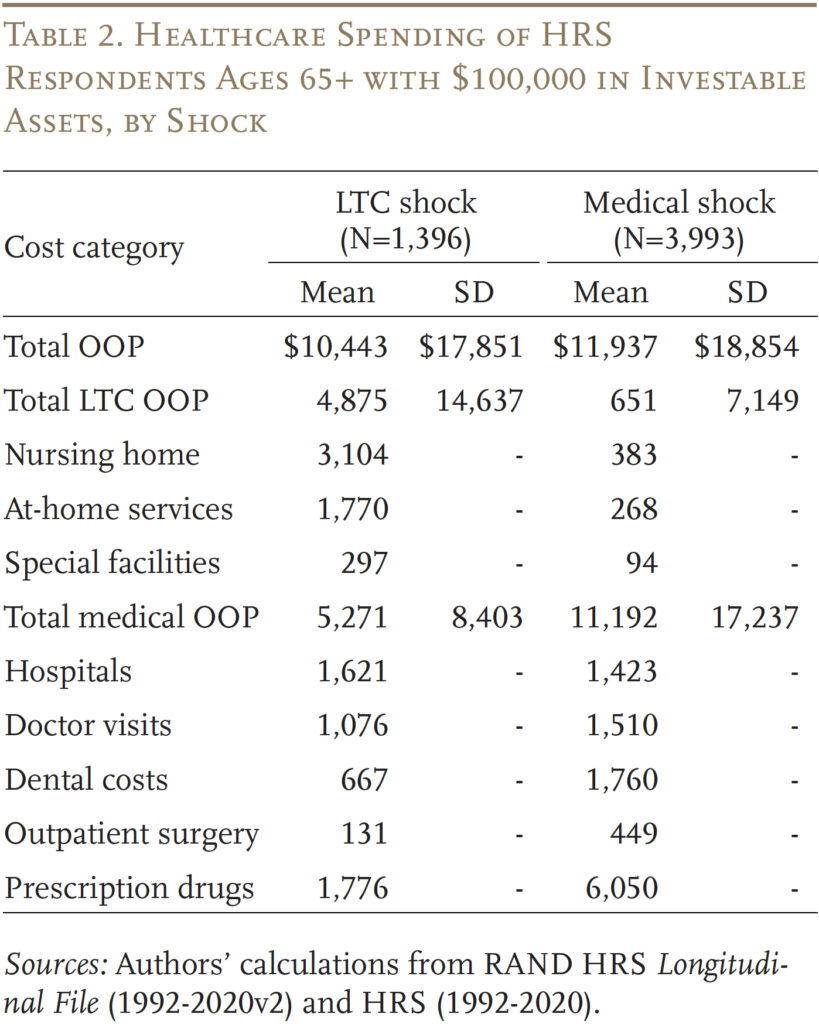
Affect of Lengthy-term Care Shocks
With this context in thoughts, Figures 5 via 7 present the impacts of an LTC shock on quite a lot of outcomes.14 First and most putting, Determine 5 exhibits that the share of people coated by Medicaid will increase dramatically, by 6.6 proportion factors, within the 12 months of the LTC shock, and will increase but once more the next 12 months to 9 proportion factors above the comparability group. These will increase are monumental in relation to the baseline charge of Medicaid protection on this inhabitants of 4 % earlier than the shock. Moreover, previous to the shock, the shock and management teams transfer in parallel, as evidenced by the dearth of serious variations in years -4 to -1. Thus, these findings counsel that the LTC shock was the purpose for the rise in Medicaid enrollment.
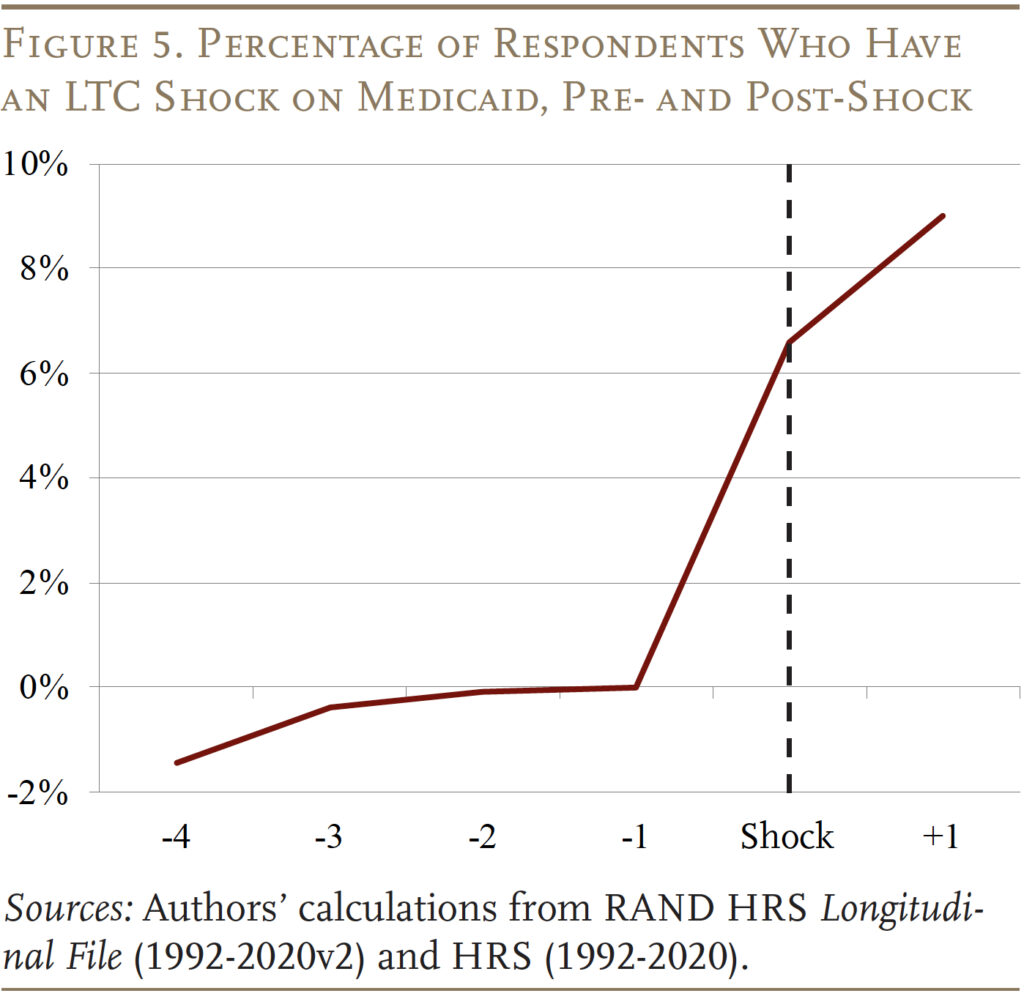
Medicaid, nevertheless, is just not a great resolution for many households, because it requires the family to forfeit just about all its wealth. Certainly, one other current research of ours discovered that solely about 15 % of households with $100,000+ in investable property will truly find yourself on Medicaid.15 So, it’s fairly stunning that 61 % of respondents within the current survey stated that they might contemplate spending down property to qualify for Medicaid. On the similar time, few survey respondents anticipated to faucet their residence fairness to cowl prices. The truth is, although, the online value of households hit by an LTC shock declined within the 12 months of the shock by $78,200, relative to the comparability group. And the estimated decline within the worth of the first residence in Determine 6 suggests households do draw down their residence fairness to finance LTC shocks.16
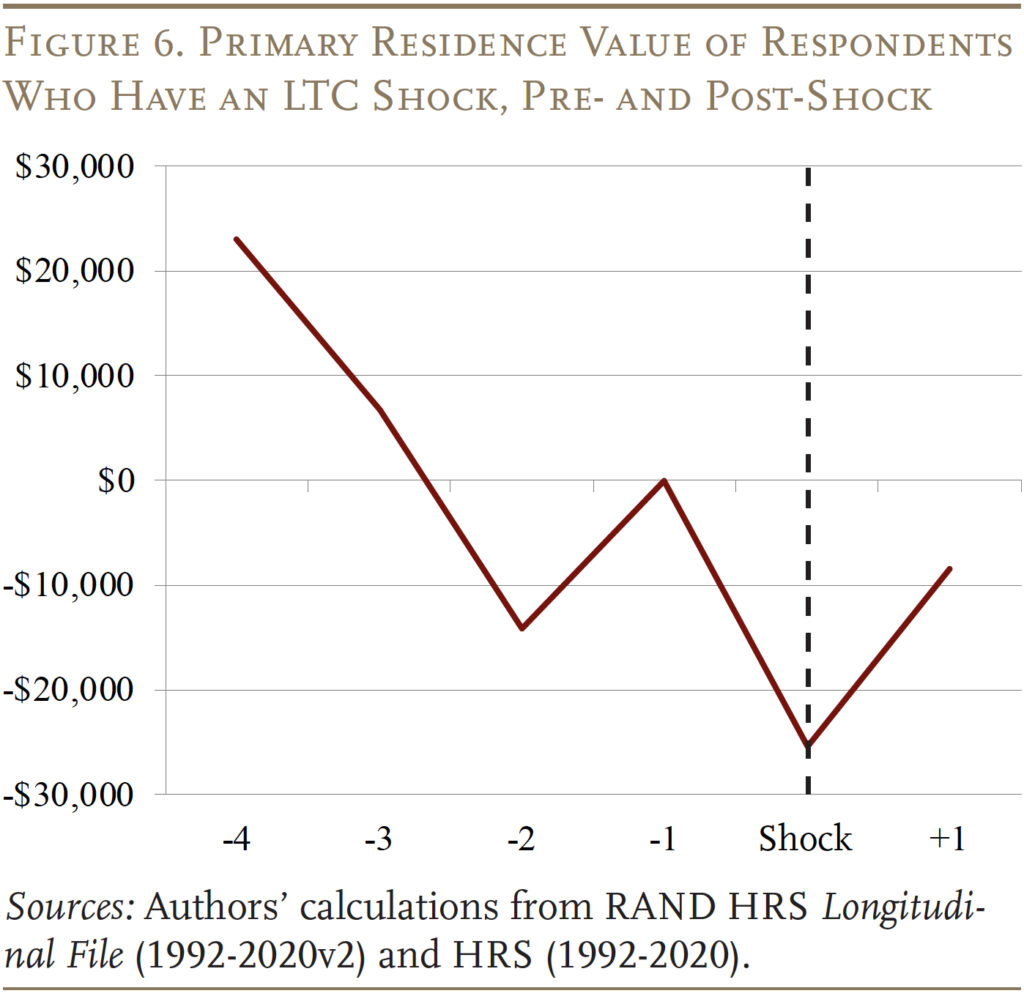
One other method people can finance LTC is by decreasing the quantity they put aside for bequests. Some economists have argued that bequests are a luxurious good (a great that folks purchase disproportionately extra of as their earnings will increase) and, as such, holding property in reserve for bequests if people don’t want a lot LTC is complementary to utilizing such reserves to finance that care.17 The outcomes are in line with this mannequin: the people within the evaluation cut back their anticipated likelihood of leaving bequests of $100,000+, because of an LTC shock (see Determine 7). The decline is modest in magnitude, at 4 proportion factors, however such likelihood questions are notoriously insensitive as respondents are likely to spherical their solutions considerably.18
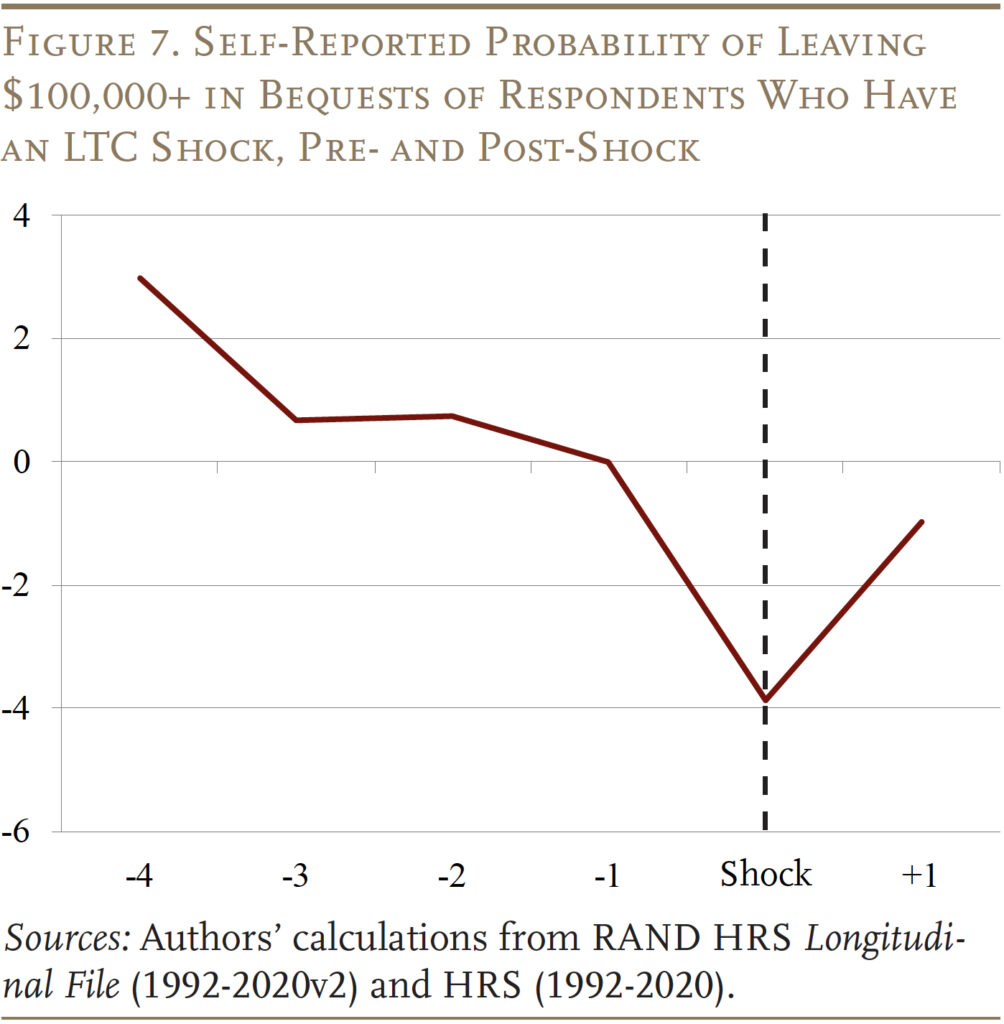
Lastly, some consolation might be taken in the truth that the outcomes present no proof that people that suffer an LTC shock transfer in with their kids or transfer nearer to their kids (or that their kids transfer nearer to them). This sample is in line with the distinct choice of respondents within the survey to solely transfer in with their youngsters as a final resort.19
In sum, people appear to have three foremost strategies of absorbing LTC shocks in observe: drawing down wealth (significantly their residence fairness); probably as a consequence, decreasing their supposed bequests, a minimum of for modest bequest sizes; and falling again on the quintessential security web, Medicaid. All of those outcomes are qualitatively related when the pattern is just not restricted to households with $100,000+ in monetary property.20
Affect of Medical Shocks
In distinction to the impacts of LTC shocks, the impacts of medical shocks are literally very restricted. No statistically important affect is discovered on any of the outcomes, apart from the anticipated likelihood of leaving a bequest of $100,000+ (see Determine 8), which is marginally important on the 10-percent stage.
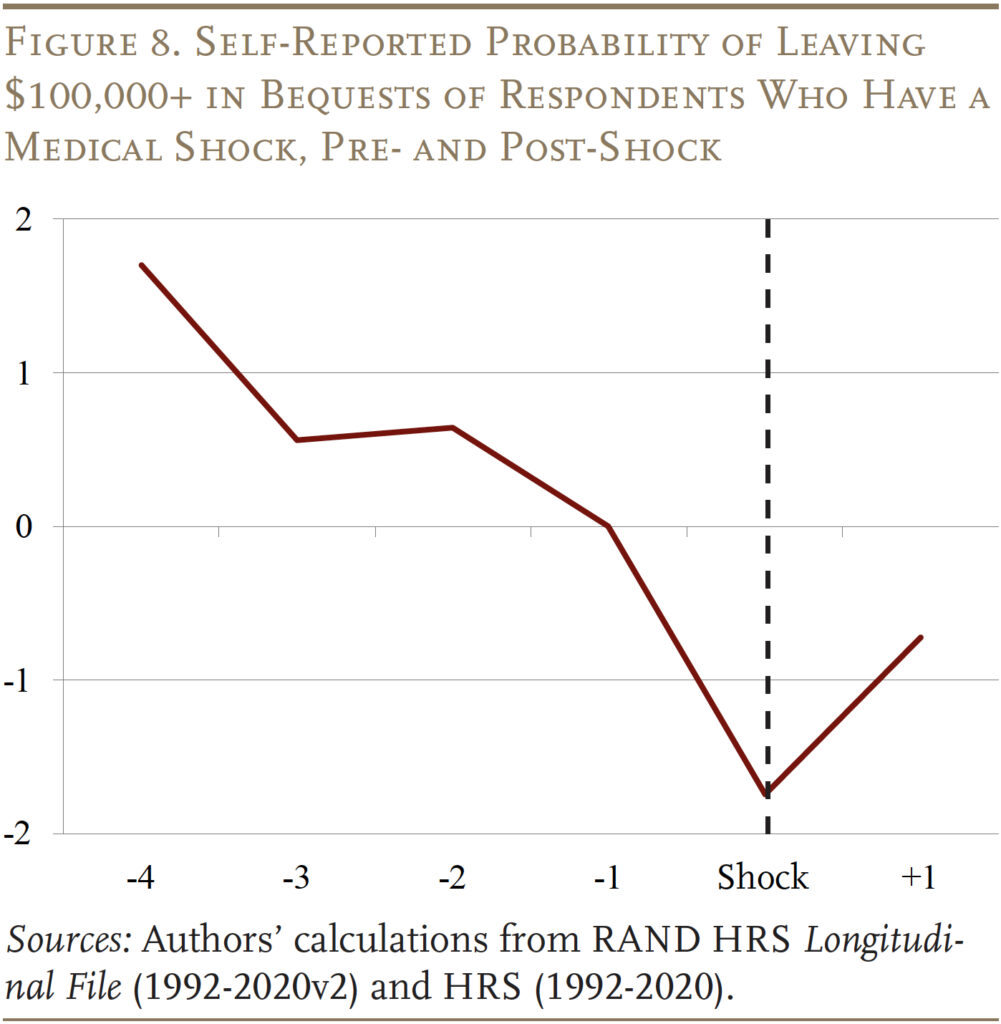
Total, the outcomes present suggestive proof that households are pretty well-insured in opposition to medical shocks. This discovering is in sharp distinction to LTC shocks, which is puzzling provided that the magnitude of the monetary hit within the 12 months of the shock is comparable for each sorts of shocks. A doable clarification is the persistence of shocks – whereas a medical shock is probably going predictive of some future bills, an LTC shock is more likely to point a completely elevated stage of future expenditures. This distinction in anticipated future prices is compounded by the truth that medical insurance isn’t exhausted, whereas LTC insurance coverage sometimes has lifetime limits.21
Conclusion
Insurance coverage not often provides full safety from danger, and within the case of healthcare dangers, these shortcomings might be substantial. Massive OOP healthcare expenditures are a sign of an absence of ample insurance coverage, both fully (typical within the case of LTC) or on the margin (typical of cost-sharing in medical insurance for medical care).
The evaluation exhibits that people plan to depend on Medicaid, the primary security web program for healthcare, if their insurance coverage proves insufficient. The outcomes additionally affirm that Medicaid is, actually, the most important recourse of people struck by LTC shocks, for which personal insurance coverage protection is uncommon. Nevertheless, ultimately solely 15 % of the inhabitants finally ends up on Medicaid, a minimum of throughout the first couple of years after a shock. As a substitute, whereas survey responses counsel that folks don’t anticipate to attract down residence fairness to cope with healthcare bills, the outcomes of the HRS evaluation present that tapping fairness is definitely a typical response to LTC shocks. Such shocks additionally result in reductions in anticipated bequests.
In distinction to LTC, medical bills appear well-insured, significantly within the sense that one dangerous 12 months doesn’t predict terribly high-cost future years. Moreover, medical insurance doesn’t sometimes characteristic lifetime limits, in distinction to LTC insurance coverage (and Medicare protection for shut LTC substitutes similar to prolonged hospital stays). Accordingly, the outcomes counsel that the one main adjustment by people hit with a medical spending shock is a decline in anticipated bequests.
Total, the outcomes converse to the relative lack of safety retirees have in opposition to LTC shocks, and underscore the significance of Medicaid as a payer of final resort for individuals who develop LTC wants at older ages.
References
American Affiliation for Lengthy-term Care Insurance coverage. 2020. “Lengthy-Time period Care Insurance coverage Information- Information- Statistics- 2020 Reviews.” Westlake Village, CA.
Belbase, Anek, Anqi Chen, and Alicia H. Munnell. 2021. “What Sources Do Retirees Have for Lengthy-Time period Providers and Helps?” Challenge in Temporary 21-15. Chestnut Hill, MA: Middle for Retirement Analysis at Boston Faculty.
Boccuti, Cristina, Gretchen Jacobsen, Kendal Orgera, and Tricia Neuman. 2018. “Medigap Enrollment and Shopper Protections Fluctuate Throughout States.” Challenge Temporary. San Francisco, CA: Kaiser Household Basis.
Chen, Anqi, Alicia H. Munnell, and Gal Wettstein. 2025a. “An Overview of Healthcare Dangers in Retirement.” Particular Report. Chestnut Hill, MA: Middle for Retirement Analysis at Boston Faculty.
Chen, Anqi, Alicia H. Munnell, and Gal Wettstein. 2025b. “Do Retirement Buyers Precisely Understand Healthcare Dangers, and Do Advisors Assist?” Working Paper 2025-3. Chestnut Hill, MA: Middle for Retirement Analysis at Boston Faculty.
Chen, Anqi, Alicia H. Munnell, and Gal Wettstein. 2025 (forthcoming). “How Do Retirees Address Uninsured Healthcare Prices?” Working Paper. Chestnut Hill, MA: Middle for Retirement Analysis at Boston Faculty.
De Nardi, Mariacristina, Eric French, and John B. Jones. 2010. “Why Do the Aged Save? The Function of Medical Bills.” Journal of Political Financial system 118(1): 39-75.
Fadlon, Itzik, and Torben Heien Nielsen. 2021. “Household Labor Provide Responses to Extreme Well being Shocks: Proof from Danish Administrative Data.” American Financial Journal: Utilized Economics 13(3): 1-30.
Freed, Meredith, Jeannie Fuglesten Biniek, Anthony Damico, and Tricia Neuman. 2024. “Medicare Benefit in 2024: Premiums, Out-of-Pocket Limits, Supplemental Advantages, and Prior Authorization.” Challenge Temporary. San Francisco, CA: KFF.
Genworth Monetary. 2023. “Price of Care Survey.” Wellesley Hills, MA.
Gruber, Jonathan and Kathleen M. McGarry. 2023. “Lengthy-Time period Care in america.” Working Paper 31881. Cambridge, MA: Nationwide Bureau of Financial Analysis.
Hendren, Nathaniel. 2013. “Personal Info and Insurance coverage Rejections.” Econometrica 81(5): 1713-1762.
Hou, Wenliang. 2020. “How Correct are Retirees’ Assessments of their Retirement Threat?” Working Paper 2020-14. Chestnut Hill, MA: Middle for Retirement Analysis at Boston Faculty.
Hubbard, R. Glenn, Jonathan Skinner, and Stephen P. Zeldes. 1995. “Precautionary Saving and Social Insurance coverage.” Journal of Political Financial system 103(2): 360-399.
Jones, John Bailey, Maracristina De Nardi, Eric French, Rory McGee, and Rachel Rodgers. 2020. “Medical Spending, Bequests, and Asset Dynamics across the Time of Demise.” Financial Quarterly 106(4): 135-157.
Lindstrom, Rachel, Katherine Keisler-Starkey, and Lisa Bunch. 2024. “Share of Older Adults with Each Personal Well being Insurance coverage and Medicare Decreased from 2017 to 2022.” Washington, DC: U.S. Census Bureau.
Lockwood, Lee M. 2018. “Incidental Bequests and the Option to Self-Insurance coverage Late-Life Dangers.” American Financial Evaluate 108(9): 2513-2550.
Ochieng, Nancy, Jeannie Fuglesten Biniek, Meredith Freed, Anthony Damico, and Tricia Neuman. 2023. “Medicare Benefit in 2023: Premiums, Out-of-Pocket Limits, Price Sharing, Supplemental Advantages, Prior Authorization, and Star Scores.” Challenge Temporary. San Francisco, CA: KFF.
Poterba, James, Steven Venti, and David Clever. 2011. “The Composition and Drawdown of Wealth in Retirement.” Journal of Financial Views 25(4): 95-118.
RAND. Well being and Retirement Examine Longitudinal File, 1992-2020v2. Santa Monica, CA.
Tolbert, Jennifer, Patrick Drake, and Anthony Damico. 2023. “Key Information in regards to the Uninsured Inhabitants.” Challenge Temporary. San Francisco, CA: KFF.
College of Michigan. Well being and Retirement Examine, 1992-2020. Ann Arbor, MI.

